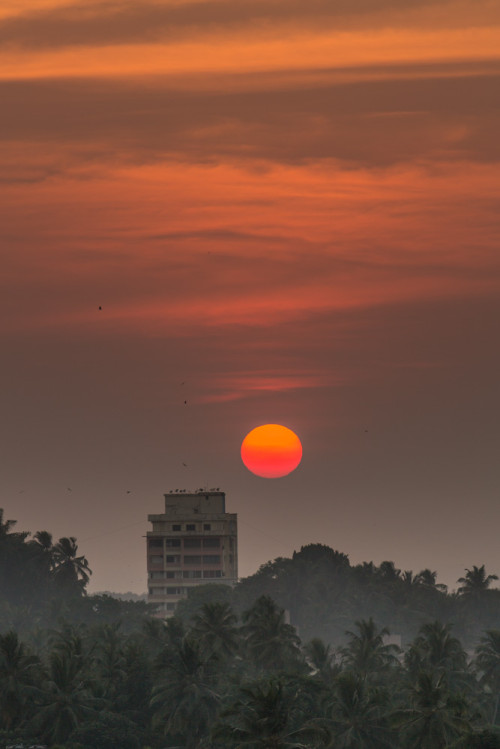
Here is a sunset I witnessed near the Software Technology Park, Derebail Mangalore. Sun was setting over the Mangalore landscape of coconut grooves, evening haze along with smoke. You can see quite a few black kites flying in the sky. I wanted to show you how the same sunset looks when shot using three different lenses of various focal lengths. I used my Canon EF 300mm f/2.8L II IS USM, Canon EF 100mm f/2.8L Macro IS USM and Canon EF 16-35mm f/2.8 L USM Lens on Canon EOS 5D Mark III body to take these photos. The purpose of my shooting was to show how the change of focal lengths affect the way we see the photos. I was creating a series of pictures for my upcoming workshop on Fundamentals of Photography. As you can see each focal length produces interesting as well as different look for the same sunset.

Understanding camera lenses can help add more creative control to digital photography. Choosing the right lens for the task can become a complex trade-off between cost, size, weight, lens speed and image quality. The focal length of a lens determines its angle of view, and thus also how much the subject will be magnified for a given photographic position. Wide angle lenses have short focal lengths, while telephoto lenses have longer corresponding focal lengths. Many will say that focal length also determines the perspective of an image, but strictly speaking, perspective only changes with one’s location relative to their subject. If one tries to fill the frame with the same subjects using both a wide angle and telephoto lens, then perspective does indeed change, because one is forced to move closer or further from their subject. For these scenarios only, the wide angle lens exaggerates or stretches perspective, whereas the telephoto lens compresses or flattens perspective. In this test I was stationary and took the photograph from the same position using 3 different lenses, so this perspective difference is not visible.

Other factors may also be influenced by lens focal length. Telephoto lenses are more susceptible to camera shake since small hand movements become magnified, similar to the shakiness experience while trying to look through binoculars. Wide angle lenses are generally more resistant to flare, in part because the designers assume that the sun is more likely to be within the frame. A final consideration is that medium and telephoto lenses generally yield better optical quality for similar price ranges. A wide angle lens can be a powerful tool for exaggerating depth and relative size in a photo. However, it’s also one of the most difficult types of lenses to learn how to use.
A common hurdle with wide angle lenses is strong variation in the intensity of light across an image. Using an ordinary exposure, uneven light can make some parts of the image over-exposed, while also leaving other parts underexposed — even though our eye would have adjusted to this changing brightness as we looked in different directions. One therefore needs to take extra care when determining the desired exposure. Telephoto lenses enlarge distant subjects. They are also a powerful tool for affecting the look of your subject. They can normalize the size and distance difference between near and far objects, and can make the depth of field appear more shallow.

When you shoot a Sunset shot one of the important thing to remember is to not to over expose the sky. If you follow the camera’s meter reading it will over expose, as the bright sun inside the frame, will fool the meter. Under-exposure, will allow you to get vivid colors of the setting sun. I usually use spot metering mode and select a location about 30 degrees off the sun and take meter reading. You can also set your camera for negative EV compensation of 1 to 2 stops, depending on the situation, if you don’t want to try spot metering and will be able to get great results.

The most interesting sunsets are those where light clouds and haze are in the sky. The haze will make a very dramatic sky. The sunlight coming through the clouds will create deep reds and purples, which will help you create a strong scene. Silhouettes are created when we back light the subject, thus creating strong under exposure.
Sunsets are ideal place to experiment with silhouettes. Turn the auto focus off and shift to manual focus as the sensor will not be able to focus properly on the sky which lacks contrast. Else you will end up with a blurred picture. If you have a foreground object in your photo, focus on that than focusing infinity. Do not belive the infinity marking on the lens. It is variable for different temperature conditions.

Do not leave as soon as the sun sets as most people do. After the sun sets, and the light is low, the long exposure can give you lots of interesting opportunities. Setting long exposure, when the sea is in the frame, will create a smooth/misty surface, depending on the amount of waves. Sometimes, when the sun has just set, the light is still too strong, you can use an ND filter to reduce the light brightness.
Best composition will be to place the sun at one of the sides of the frame, rather than at the center, this will help you to create more interest in the frame. Also, try and place some other interesting objects in the frame, other than the sun. Finally an important warning – Do not look directly at the sun, no matter what! Not with your bare eyes, and not through the eyepiece, it can cause irreversible damage to your eyes.

